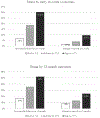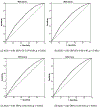Validation of a Secondary Screener for Suicide Risk: Results from the Emergency Department Safety Assessment and Follow-up Evaluation (ED-SAFE)
- PMID: 32417230
- PMCID: PMC7276296
- DOI: 10.1016/j.jcjq.2020.03.008
Validation of a Secondary Screener for Suicide Risk: Results from the Emergency Department Safety Assessment and Follow-up Evaluation (ED-SAFE)
Abstract
Background: Validated secondary screeners are needed to stratify suicide risk among those with nonnegligible risk. This study tested the predictive utility of the Emergency Department Safety Assessment and Follow-up Evaluation (ED-SAFE) Secondary Screener (ESS), one of the screeners listed by The Joint Commission's Patient Safety Goal 15 resources as a potential secondary screener for acute care settings.
Methods: The researchers performed secondary analyses of data collected for the ED-SAFE study. Data were collected during an emergency department (ED) visit for 1,376 patients who endorsed active suicide ideation or a suicide attempt in the past week. Participants were followed for 12 months using telephone-based assessments, review of health care records, and National Death Index query. The study examined the predictive validity of the individual items, total score, and a scoring algorithm using the total score and critical items. Bivariable analyses, multivariable logistic regression, and test operating characteristics were calculated.
Results: Of the 1,376 patients enrolled, most were positive for at least one indicator. Four of the indicators were significantly associated with several outcomes. Based on score and critical items, the patients were trichotomized: The three strata were associated with significantly different rates of prospective suicidal behavior, with 52% of the high-risk group engaging in suicidal behavior within 12 months.
Conclusion: The ESS possesses adequate operating characteristics for triage purposes. The researchers recommend validation in new samples to confirm its operating characteristics and potentially reduce its length by removing the substance and agitation items, which offered little predictive utility in this study.
Copyright © 2020 The Joint Commission. Published by Elsevier Inc. All rights reserved.
Conflict of interest statement
Conflicts of Interest All authors report no conflicts of interest.
Figures



References
-
- Moore BJ, et al. Trends in emergency department visits, 2006–2014 Statistical Brief #227. Rockville, MD: Agency for Healthcare Research and Quality, 2017. Accessed May 30, 2019 https://www.hcup-us.ahrq.gov/reports/statbriefs/sb227-Emergency-Departme...
-
- Owens PL, et al. Emergency department visits related to suicidal ideation, 2006–2013 Statistical Brief #220. Rockville, MD: Agency for Healthcare Research and Quality, 2017. Accessed May 30, 2019 https://www.ncbi.nlm.nih.gov/books/NBK442036/
-
- Allen MH, et al. Screening for suicidal ideation and attempts among emergency department medical patients: Instrument and results from the Psychiatric Emergency Research Collaboration. Suicide Life Threat Behav. 2013;43(3):313–323. - PubMed
-
- Claassen CA, et al. Occult suicidality in an emergency department population. Br J Psychiatry. 2005;186:352–353. - PubMed
Publication types
MeSH terms
Grants and funding
LinkOut - more resources
Full Text Sources
Medical
Miscellaneous

